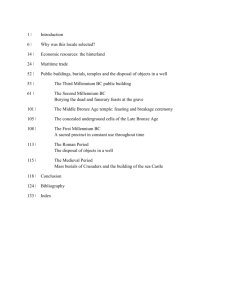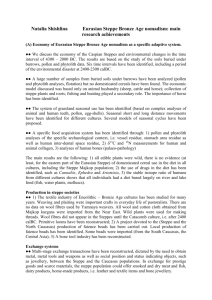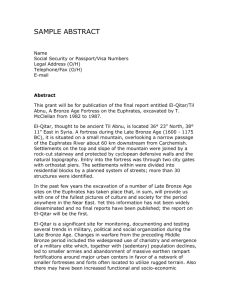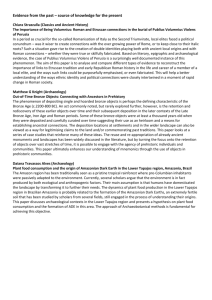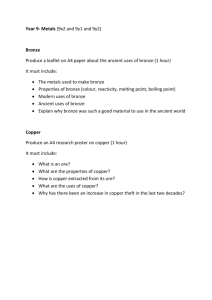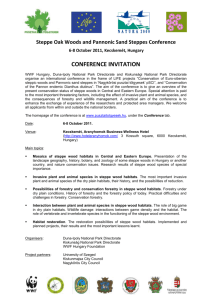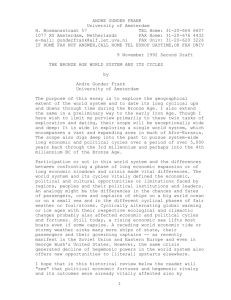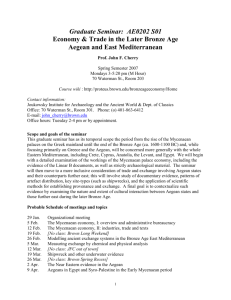The mysterious Bronze Age steppe nomads
advertisement
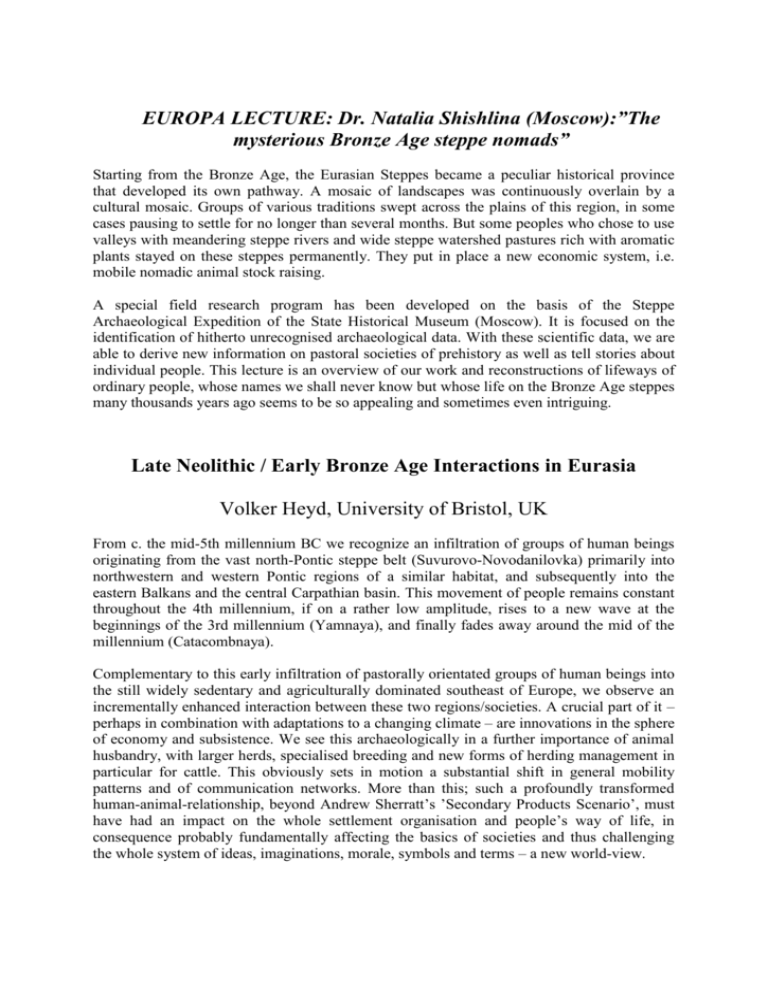
EUROPA LECTURE: Dr. Natalia Shishlina (Moscow):”The mysterious Bronze Age steppe nomads” Starting from the Bronze Age, the Eurasian Steppes became a peculiar historical province that developed its own pathway. A mosaic of landscapes was continuously overlain by a cultural mosaic. Groups of various traditions swept across the plains of this region, in some cases pausing to settle for no longer than several months. But some peoples who chose to use valleys with meandering steppe rivers and wide steppe watershed pastures rich with aromatic plants stayed on these steppes permanently. They put in place a new economic system, i.e. mobile nomadic animal stock raising. A special field research program has been developed on the basis of the Steppe Archaeological Expedition of the State Historical Museum (Moscow). It is focused on the identification of hitherto unrecognised archaeological data. With these scientific data, we are able to derive new information on pastoral societies of prehistory as well as tell stories about individual people. This lecture is an overview of our work and reconstructions of lifeways of ordinary people, whose names we shall never know but whose life on the Bronze Age steppes many thousands years ago seems to be so appealing and sometimes even intriguing. Late Neolithic / Early Bronze Age Interactions in Eurasia Volker Heyd, University of Bristol, UK From c. the mid-5th millennium BC we recognize an infiltration of groups of human beings originating from the vast north-Pontic steppe belt (Suvurovo-Novodanilovka) primarily into northwestern and western Pontic regions of a similar habitat, and subsequently into the eastern Balkans and the central Carpathian basin. This movement of people remains constant throughout the 4th millennium, if on a rather low amplitude, rises to a new wave at the beginnings of the 3rd millennium (Yamnaya), and finally fades away around the mid of the millennium (Catacombnaya). Complementary to this early infiltration of pastorally orientated groups of human beings into the still widely sedentary and agriculturally dominated southeast of Europe, we observe an incrementally enhanced interaction between these two regions/societies. A crucial part of it – perhaps in combination with adaptations to a changing climate – are innovations in the sphere of economy and subsistence. We see this archaeologically in a further importance of animal husbandry, with larger herds, specialised breeding and new forms of herding management in particular for cattle. This obviously sets in motion a substantial shift in general mobility patterns and of communication networks. More than this; such a profoundly transformed human-animal-relationship, beyond Andrew Sherratt’s ’Secondary Products Scenario’, must have had an impact on the whole settlement organisation and people’s way of life, in consequence probably fundamentally affecting the basics of societies and thus challenging the whole system of ideas, imaginations, morale, symbols and terms – a new world-view. This brief summary of events in circum-Pontic southeast Europe, and in an interaction zone around it, can be an explanatory model for the fundamental changes that we observe in the archaeological records in adjacent parts of Europe from the middle Copper Age in the mid-4th millennium and then throughout the whole late Copper Age: The emergence of so-called cultural phenomena, hence super-regional and integrative, ideologically-driven expansionist systems, that incorporate with huge distribution areas region after region of the Central and Northern parts and then the West and the edges of the European continent. Their typical representatives are, first, Cernavodă III-/Boleráz and the Baden sequence in southeast Europe and in the Carpathian basin, as well as the Globular Amphora culture North of the Carpathian bow and in Central Europe; then from the first quarter of the 3rd millennium onwards the Corded Ware/Single Grave/Battle Axe cultural complex, and finally the Bell Beakers, with those nearly the whole Continent is covered from c. 2500-2100 BC. “How Eurasia was incorporated into a Near Eastern worldsystem” Kristian Kristiansen Eurasian interactions (east-west/west-east) were strong during both the 3rd and 2nd millennia BC. However north-south interaction with the Near East, Anatolia and Greece added selected attributes to European Bronze Age societies, just as technological innovations such as the two-wheeled war chariot was adopted, sometimes through force, in the Near East and Greece. In this presentation, I consider the historical links between Scandinavia, the steppe and India during the early to mid-2nd millennium BC, and some of the institutional and cosmological transmissions that resulted from this period of large-scale interaction and conquest. The Ancient Near East as a Dynamic System T. J. Wilkinson In the Near East, trade and regional interactions have for many years been framed within large-scale narratives, often represented by numerous dots and large arrows on maps. It is also necessary, however, to examine how such interactions occurred at the local level. Specifically I shall critically examine the tension between the aggregate actions of individuals and much broader-scale narratives at the pan-regional level and ask the question: “how can actions at the local level be “scaled up” to capture the most broad-scale interactions?” In addition, I outline how new generations of data are enabling us to see how inter-regional route systems were configured on the ground and perhaps how they operated. Emphasis will also be upon the dynamic nature of polities and early states and how the actions of aggressive kings might have influenced inter-regional exchange systems. Core-periphery models will also be discussed and related to earlier models. Finally, a new generation of obsidian analysis is shedding light on inter-regional interactions. Specifically, such investigations relate to the expansive polities of Northern Syria and their links with Anatolia, as well as to new work on pan-Arabian obsidian trade and connections between Arabia and NE Africa. The Aegean and the eastern Mediterranean in the Bronze Age Cultural interaction and social change Sofia Voutsaki Interaction in the eastern Mediterranean is a complex phenomenon, characterized by fluctuations through time, regional variation and the uneven participation of social groups. In this paper, an attempt will be made to explore cycles of increased connectivity and contraction during the Aegean Bronze Age (3000 – 1000 BC) by focusing on the interplay between internal developments and external stimuli. Emphasis will be given to spatial variation and shifts in the centre of gravity, as different regions within the Aegean (the Cyclades, Crete and the mainland, but also different sub-regions within them) become incorporated into the wider world of the eastern Mediterranean in varying degrees, acquire a prominent position in the network of exchanges only to fade out of importance a few centuries later. An effort will also be made to reconstruct patterns of participation in this web of exchanges and alliances from which some social groups benefit, while others are emphatically excluded. However, sketching the broader picture of spatio-temporal variation or social differentiation is not sufficient: we need to understand social agency and individual motivation - to put it another way, we need to explore how the participants themselves negotiated their own position in a changing world. This will be attempted by analyzing specific events, such as the composition of the valuable cargo of one shipwreck, or the burial assemblage of one well-connected person. My main argument in this paper is that the integration of the Aegean societies into the wider world of the eastern Mediterranean brought about a deeper transformation which affected the entire social body and caused a pervasive re-definition of cultural and personal identities. Atlantic metals and interactions in the Chalcolithic and Early Bronze Age" William O’Brien This paper will examine the spread of metallurgy in Atlantic Europe during the third millennium BC, in relation to the supply of copper and bronze from sources in Northern Spain, France, Britain and Ireland. The geological setting and technological background of the first Atlantic metallurgy will be considered, with reference to the widespread development of fahlerz metallurgy and subsequently the adoption of tin bronze. The central position of mines such as El Aramo, Cabrieres and Ross Island in regional networks of metal supply will be considered. The cultural context of this mining is explored with reference to the role of the Beaker ‘culture’ in both the circulation of metal and the dissemination of mining and metallurgical knowledge across the Atlantic zone. “Above and Below the Ethnic Surface: the scales of the Iron Age steppe economy” Timothy Taylor There exist several well-known dimensions along which we can confront the accounts of the classical authors with the finds of archaeology within the steppe zone once we arrive in the developed Iron Age. Yet the significance of the potential for this juxtaposition of data may be misunderstood. If one is a reflex of the other, then both may obscure (when they do not actively hide) significant aspects of the human experience. Some happenings which we have not allowed to become events of history, especially the experiences of statelessness, enslavement, dependence, gender inequality and peripherality, may reveal themselves in the solutions to textual puzzles and the resolution of apparently minor ambiguities in the archaeological record. We do not need to reject the traditional culture-historical or ethnogenetic interconnections between sites, artefacts, iconographies and contemporary accounts to appreciate both network-level, steppe-wide interactions and discrete, localized relations; but we may note that, insofar as they lend themselves less well to the construction of national narratives, study of these scales remains underdeveloped.
